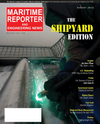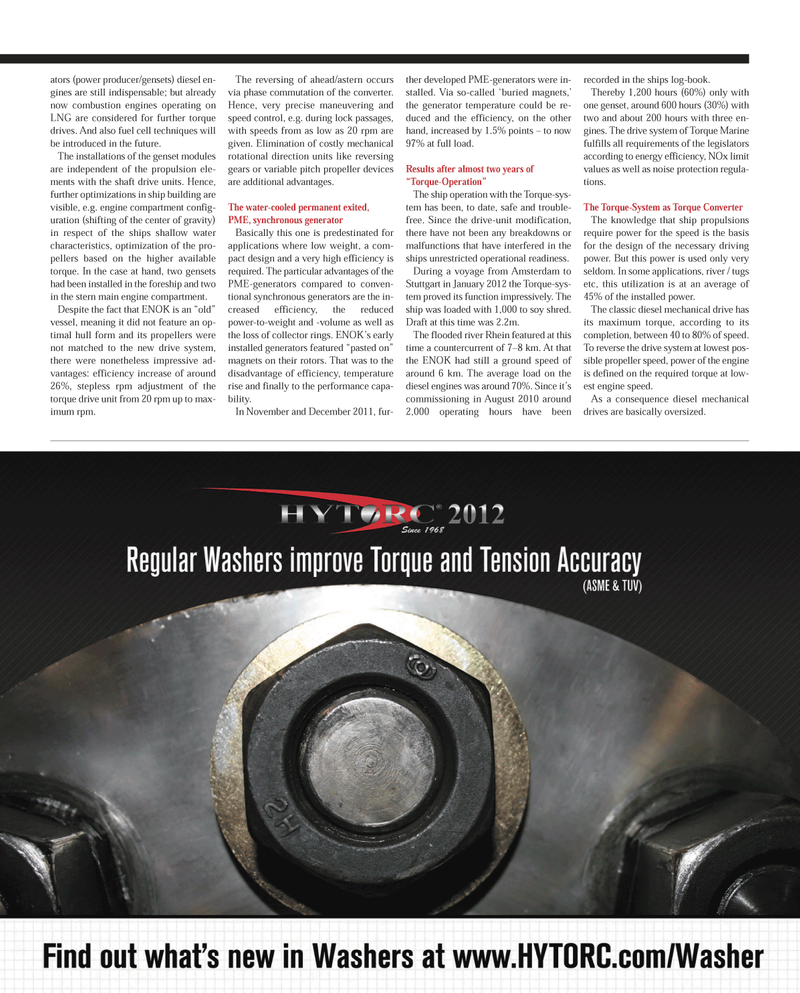
Page 37: of Maritime Reporter Magazine (August 2012)
The Shipyard Edition
Read this page in Pdf, Flash or Html5 edition of August 2012 Maritime Reporter Magazine
ators (power producer/gensets) diesel en- gines are still indispensable; but already now combustion engines operating on LNG are considered for further torquedrives. And also fuel cell techniques will be introduced in the future.The installations of the genset modulesare independent of the propulsion ele-ments with the shaft drive units. Hence, further optimizations in ship building are visible, e.g. engine compartment config- uration (shifting of the center of gravity) in respect of the ships shallow water characteristics, optimization of the pro-pellers based on the higher available torque. In the case at hand, two gensets had been installed in the foreship and two in the stern main engine compartment.Despite the fact that ENOK is an ?old? vessel, meaning it did not feature an op- timal hull form and its propellers werenot matched to the new drive system, there were nonetheless impressive ad- vantages: efficiency increase of around 26%, stepless rpm adjustment of thetorque drive unit from 20 rpm up to max- imum rpm. The reversing of ahead/astern occurs via phase commutation of the converter. Hence, very precise maneuvering and speed control, e.g. during lock passages,with speeds from as low as 20 rpm are given. Elimination of costly mechanical rotational direction units like reversing gears or variable pitch propeller devices are additional advantages. The water-cooled permanent exited, PME, synchronous generator Basically this one is predestinated forapplications where low weight, a com- pact design and a very high efficiency is required. The particular advantages of the PME-generators compared to conven- tional synchronous generators are the in-creased efficiency, the reduced power-to-weight and -volume as well as the loss of collector rings. ENOK?s early installed generators featured ?pasted on?magnets on their rotors. That was to the disadvantage of efficiency, temperature rise and finally to the performance capa- bility. In November and December 2011, fur- ther developed PME-generators were in- stalled. Via so-called ?buried magnets,? the generator temperature could be re-duced and the efficiency, on the other hand, increased by 1.5% points ? to now 97% at full load.Results after almost two years of ?Torque-Operation? The ship operation with the Torque-sys- tem has been, to date, safe and trouble-free. Since the drive-unit modification, there have not been any breakdowns or malfunctions that have interfered in the ships unrestricted operational readiness.During a voyage from Amsterdam to Stuttgart in January 2012 the Torque-sys- tem proved its function impressively. The ship was loaded with 1,000 to soy shred. Draft at this time was 2.2m. The flooded river Rhein featured at this time a countercurrent of 7?8 km. At that the ENOK had still a ground speed ofaround 6 km. The average load on the diesel engines was around 70%. Since it?s commissioning in August 2010 around 2,000 operating hours have been recorded in the ships log-book. Thereby 1,200 hours (60%) only withone genset, around 600 hours (30%) withtwo and about 200 hours with three en- gines. The drive system of Torque Marine fulfills all requirements of the legislators according to energy efficiency, NOx limit values as well as noise protection regula- tions.The Torque-System as Torque Converter The knowledge that ship propulsions require power for the speed is the basis for the design of the necessary driving power. But this power is used only very seldom. In some applications, river / tugs etc, this utilization is at an average of 45% of the installed power. The classic diesel mechanical drive has its maximum torque, according to itscompletion, between 40 to 80% of speed.To reverse the drive system at lowest pos- sible propeller speed, power of the engine is defined on the required torque at low- est engine speed. As a consequence diesel mechanicaldrives are basically oversized. MR#8 (34-41):MR Template 8/8/2012 3:14 PM Page 37

 36
36

 38
38
